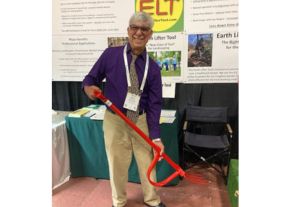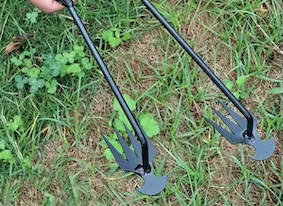The EarthLifter Tool for Easier Digging
Views: 872

Got a bad back or find it difficult to perform lifting and pulling tasks in the garden? The EarthLifter tool can help with that. I was able to test drive the EarthLifter while attending a trade show recently. It’s a tool whose form and physics allows you to use less effort when going about your digging chores. And you know what that means? It means you can work in your garden even if you think your body doesn’t have the strength.
How the EarthLifter Works
The EarthLifter is a deceptively simple tool. Its working end is a garden fork or a spading fork—so it has strong tines. And just up the 1020 hollow steel shaft is a U-shaped extension. This piece of tubing along the shaft acts as a “rolling fulcrum.” A fulcrum is the pivot around which a lever turns. A seesaw is an example of a fulcrum and lever, with the triangle base upon which the board rests being the fulcrum and the board is the lever. A person on one end of the seesaw—the one in the down position—is the load in this physics equation and the person up in the air at the other end is the effort. The person up in the air exerts effort downward and along the length of the lever to lift the load at the other end.
Now let’s look at the EarthLifter as lever, fulcrum, load and effort. The U-shaped piece attached to the EarthLifter’s shaft is that upside-down triangle base that is the fulcrum. The shaft is the lever. Insert the fork tines into the ground to the point where the fulcrum is. Whatever resistance the tines meet is the load. Now press downward on the shaft’s handle and that’s the effort which lifts whatever load is at the other end.
Less Effort
Compare that process to what you might do with a traditional garden fork. You’d insert the tines into the ground to about the same level as the EarthLifter. At that point you would have to bring one hand midway down the shaft or lower, which requires bending your knees and spine. That arm sort of acts as fulcrum to loosen the soil at first, and then your whole upper body engages to pull that weight up. With the EarthLifter, on the other hand, you’re pushing down instead of lifting up. Sure, there’s some lifting involved once whatever you are dislodging from the soil has made it to the soil surface, but the major resistance—the “stuckness” of your object in the soil—has been overcome with less effort on your part.
EarthLifter’s Uses
Use the EarthLifter for whatever you might use a garden fork for. For instance, you can loosen and dig up your tuber or bulb crops—potatoes, sweet potatoes, turnips, garlic and so on. Uproot your dahlias and store them for the winter with a lot less effort, too. Dig up some perennials for spring division. Some weeds with giant root balls can be removed with this tool, as well.
The great thing about the EarthLifter is that it allows people whose strength has waned, who have bad backs, or who have an inability to fully use their hands or arms to be able to tackle difficult digging tasks. The inventor himself has a hand injury, which prompted him to find a solution for his digging needs. If you or someone you know are finding certain garden tasks to be more effortful than in previous years, the EarthLifter can help you continue your gardening hobbies.
You can find the EarthLifter at a local retailer, and if not, head over to EarthLifer.com to purchase one.
Meet Ellen Wells
When you’re raised on a farm, you can’t help but know a thing or two about gardening. Ellen Wells is our expert on edible gardening.…







